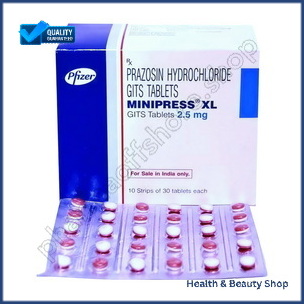ADDICTION
ALCOHOL DEPENDENCE
QUIT SMOKING
ALLERGY
ANTI FUNGAL
FUNGAL INFECTION
FUNGAL NAIL INFECTIONS
ANTI-REJECTION DRUGS
ANTI WORM
ANTIBIOTIC
BACTERIAL INFECTIONS
ARTHRITIS
GOUT
OSTEOARTHRITIS
RHEUMATOID ARTHRITIS
BLOOD
LOW PLATELET COUNT
THROMBOPHLEBITIS
VARICOSE VEINS
COLON
ANAL FISSURE
PILES
ULCERATIVE COLITIS
DIABETES CARE
DIABETES INSIPIDUS
DIABETES TYPE
DIABETIC FOOT ULCERS
GLUCOSE MONITOR
EYES/EAR CARE
DRY EYES
EYE CARE
EYE EXAMINATION
EYE INFECTION
EYE LASHES
EYE PAIN
GLAUCOMA
OCULAR HYPERTENSION
UVEITIS
FEVER CARE
MALARIA
RHEUMATIC FEVER
TYPHOID FEVER
GASTROINTESTINAL
ACIDITY
CONSTIPATION
CROHN'S DISEASE
DIARRHOEA
GALLBLADDER STONES
INTESTINAL ULCERS
IRRITABLE BOWEL SYNDROME
MOTION SICKNESS
NAUSEA
Minipress Xl 2.5 mg (Prazosin)
| Active Ingredient (Generic Name): | Prazosin |
|---|---|
| Indication: | High blood pressure, Raynaud’s disease |
| Manufacturer: | Pfizer India Ltd |
| Packaging: | 30 tablets in one strip |
| Strength: | 2.5 mg |
From: $28.00
Minipress Xl 2.5 mg, a medication containing prazosin, is prescribed to lower blood pressure and treat conditions like benign prostatic hyperplasia and post-traumatic stress disorder. Prazosin blocks alpha-1 receptors, relaxing and dilating blood vessels, and slowing heart rate. The typical dosage is 1 mg to 2 mg once daily. Possible side effects include dizziness, lightheadedness, and headaches. It is essential to take the medication as directed and be aware of potential interactions and side effects.
Main Points
Minipress Xl 2.5 mg (Prazosin) is a medication used to treat hypertension and benign prostatic hyperplasia (BPH). It is also used to manage post-traumatic stress disorder (PTSD) symptoms.
The recommended starting dose is 1 mg to 2 mg, taken once daily with food at the same time each day.
Common side effects include dizziness, lightheadedness, and headaches. Rare but severe side effects may include fainting and rapid heartbeat.
Inform your doctor of all medications, including diuretics, beta-blockers, and certain antidepressants, as they can interact with Minipress Xl 2.5 mg.
Store Minipress Xl 2.5 mg in its original packaging, away from moisture and light, in a cool, dry place, out of reach of children and pets.
How Minipress Xl 2.5 mg Works
Minipress Xl 2.5 mg works by blocking alpha-1 receptors in blood vessels, causing them to relax and dilate, which lowers blood pressure. This relaxation reduces resistance to blood flow, allowing the heart to pump blood more efficiently. As a result, blood pressure decreases, and heart rate slows down.
Prazosin, the active ingredient, binds to specific receptors on muscle cells of blood vessels, reducing contraction and leading to vasodilation. This increases blood flow to organs and tissues, helping to reduce blood pressure.
Prazosin’s effects are most pronounced on peripheral blood vessels, particularly arterioles and veins. By targeting specific receptors, prazosin effectively lowers blood pressure without significantly affecting other bodily functions, minimizing potential side effects.
Uses and Benefits of Prazosin
Prazosin, a medication that relaxes and dilates blood vessels, is effective in lowering blood pressure. This reduces the risk of heart disease, stroke, and kidney disease. It also alleviates symptoms of benign prostatic hyperplasia (BPH) by relaxing muscles in the prostate and bladder neck, reducing frequent urination. Additionally, prazosin has been shown to be effective in treating post-traumatic stress disorder (PTSD) symptoms, including nightmares and sleep disturbances. It can also provide relief from anxiety and depression symptoms. By reducing anxiety and improving sleep quality, prazosin is a valuable treatment option for these conditions.
Dosage and Administration Guidelines
Dosage and Administration Guidelines for Minipress XL 2.5 mg (prazosin)
Take Minipress XL 2.5 mg as directed by your doctor. The dosage and administration schedule may vary depending on your specific condition and medical history.
The typical starting dose is 1 mg to 2 mg once daily. This dose can be increased gradually as needed and under your doctor’s supervision.
Swallow the tablets whole with a glass of water. Do not crush, chew, or divide them.
Take Minipress XL 2.5 mg at the same time each day, preferably with food or milk to minimize stomach upset.
If taking other medications, take them at least 2 hours before or after taking Minipress XL 2.5 mg to avoid potential interactions.
If you miss a dose, take it as soon as you remember, unless it’s almost time for your next scheduled dose. Do not take an extra dose to make up for the missed one.
If you’re unsure about your dosage or administration schedule, consult your doctor or pharmacist for guidance.
Possible Side Effects to Expect
Possible Side Effects of Minipress XL 2.5 mg
Minipress XL 2.5 mg can cause side effects, some common and others rare. Common side effects include dizziness, lightheadedness, headaches, nausea, vomiting, diarrhea, fatigue, weakness, and insomnia. In rare cases, more severe side effects may occur, such as fainting, rapid heartbeat, or swelling of the face, arms, or legs.
The severity of side effects varies from person to person. Not everyone will experience side effects. If you have concerns or unusual symptoms, consult your doctor. They can help manage side effects or adjust your dosage if necessary. It is essential to be informed about potential side effects to ensure your safety while taking Minipress XL 2.5 mg.
Interactions With Other Medications
Minipress XL 2.5 mg can interact with other medications, including diuretics, beta-blockers, and certain antidepressants. These interactions may alter the efficacy of Minipress XL 2.5 mg or increase the risk of adverse effects. Inform your doctor of all medications you’re currently taking, as combining them with Minipress XL 2.5 mg may lead to unwanted interactions. Diuretics can increase the risk of hypotension when taken with Minipress XL 2.5 mg. Beta-blockers may enhance the hypotensive effect of Minipress XL 2.5 mg. Certain antidepressants, such as MAOIs, can interact with Minipress XL 2.5 mg, increasing the risk of adverse effects. Report any changes in your medication regimen to your doctor, as this may affect the efficacy of Minipress XL 2.5 mg.
Precautions and Contraindications
When taking Minipress XL 2.5 mg, precautions and contraindications must be considered to ensure safe and effective treatment. Allergic reactions to prazosin can occur, and monitoring of the body’s response is crucial. Inform your doctor about all current medications to avoid adverse interactions.
Allergic Reactions to Prazosin
If you are allergic to prazosin or its ingredients, do not take Minipress XL 2.5 mg, as it can trigger severe allergic reactions. Inform your healthcare provider about any allergies you have before taking this medication.
Prazosin allergic reactions can manifest in the following ways:
- Hives: Raised welts on the skin that can appear anywhere on the body
- Itching: Skin itching sensations
- Rash: Inflamed skin
- Swollen face, lips, tongue, or throat: In severe cases, allergic reactions can cause swelling in these areas
- Difficulty breathing: In rare cases, severe allergic reactions can lead to breathing or swallowing difficulties
Interactions With Medications
Prazosin Interactions with Medications
Informing your healthcare provider about all prescription and over-the-counter medications is crucial for safe and effective Prazosin treatment. Some medications can interact with Prazosin, increasing the risk of adverse effects or reducing its efficacy.
Medication Interactions with Prazosin
| Medication | Interaction | Consequence |
|---|---|---|
| Diuretics | Increases risk of hypotension | Monitor blood pressure closely |
| Beta-blockers | Enhances hypotensive effect | Adjust dosage as needed |
| Verapamil | Increases risk of hypotension | Monitor blood pressure closely |
| Phosphodiesterase-5 inhibitors | Enhances hypotensive effect | Adjust dosage as needed |
| Anti-hypertensives | Enhances hypotensive effect | Monitor blood pressure closely |
Disclose all medications, including prescription and over-the-counter medications, vitamins, and supplements, to your healthcare provider. This enables them to adjust your treatment plan and minimize the risk of adverse interactions.
Warnings and Drug Interactions
When taking Minipress XL 2.5 mg, consider potential interactions with other medications that may impact its effectiveness or increase the risk of adverse reactions. Inform your doctor about all prescription and over-the-counter medications you’re currently taking to minimize potential risks. Understanding Minipress XL 2.5 mg’s interactions with other drugs and potential risks of adverse reactions is crucial for safe and effective treatment.
Interaction With Medications
Minipress XL 2.5 mg, containing prazosin, can interact with various medications, leading to adverse effects or reduced efficacy.
Interacting medications include:
- Diuretics: Co-administration may increase the risk of hypotension (low blood pressure).
- Beta-blockers: Combination therapy may enhance the blood pressure-lowering effect, increasing the risk of hypotension.
- Antidepressants: Certain antidepressants, such as MAOIs, can interact with Minipress XL 2.5 mg, increasing the risk of hypotension and dizziness.
- Verapamil: Co-administration may increase the risk of hypotension and bradycardia (slow heart rate).
- Phosphodiesterase-5 inhibitors: Combination therapy with phosphodiesterase-5 inhibitors, such as sildenafil, may increase the risk of hypotension.
It is essential to inform your doctor about all medications, including supplements and vitamins, to minimize the risk of adverse interactions.
Adverse Reaction Risks
Minipress XL 2.5 mg may cause adverse reactions, ranging from mild to severe. Common side effects include dizziness, headache, and drowsiness. Dry mouth, constipation, and nausea may also occur. In rare cases, low blood pressure, fainting, or allergic reactions can occur. If sensitive to prazosin, hives, itching, or swelling may occur.
Regular blood pressure monitoring is crucial, as Minipress XL 2.5 mg can cause orthostatic hypotension. This risk increases when taking other blood pressure-lowering medications. Inform your doctor of all medications, including antidepressants, sedatives, and high blood pressure medications. If unusual symptoms occur, consult your doctor immediately. Minipress XL 2.5 mg can impair reaction time and judgment; exercise caution when driving or operating heavy machinery.
Minipress Xl 2.5 mg and Pregnancy
Pregnancy and Minipress Xl 2.5 mg: Important Considerations
Before taking Minipress Xl 2.5 mg, pregnant women or those planning to become pregnant should consult their doctor. The effects of prazosin on the fetus are not well understood.
Key points to consider:
- There is limited human data on the use of prazosin during pregnancy.
- Animal studies have shown that prazosin can cross the placenta.
- High doses of prazosin have been associated with fetal harm in animal studies.
- The effects of prazosin on fetal development are not well understood.
To determine the best course of treatment, it is essential to discuss pregnancy or plans to become pregnant with your doctor. They may recommend alternative treatments or adjust your dosage based on your individual situation.
Overdose Symptoms and Treatment
If you suspect an overdose of Minipress Xl 2.5 mg, recognize the signs: dizziness, fainting, and slow heart rate. Seek immediate medical attention if you experience these symptoms. Treatment depends on the overdose severity and may involve fluid replacement and vital sign monitoring.
Signs of Overdose
Prazosin overdose symptoms include:
- CNS depression: confusion, lethargy, and decreased responsiveness
- Cardiovascular issues: hypotension, bradycardia, and cardiac conduction abnormalities
- Gastrointestinal symptoms: nausea, vomiting, and abdominal pain
- Respiratory distress: slow breathing rate, shallow breaths, and wheezing
- Other symptoms: blurred vision, fatigue, and increased sweating
If experiencing these symptoms, call emergency services or seek immediate medical attention. Prompt treatment is essential to prevent severe complications or death.
Treatment Options
Treatment of prazosin overdose involves supportive care and management of symptoms, as there is no specific antidote for prazosin toxicity.
If you’ve taken an overdose of Minipress XL 2.5 mg, your healthcare provider will focus on stabilizing your vital signs and managing any complications that arise.
Symptoms and Treatment
| Symptom | Treatment | Rationale |
|---|---|---|
| Hypotension | Fluid replacement, vasopressors | Stabilize blood pressure |
| Bradycardia | Atropine, pacemaker | Regulate heart rate |
| Respiratory depression | Oxygen therapy, ventilation | Maintain oxygen saturation |
| Seizures | Benzodiazepines, anticonvulsants | Control seizure activity |
Your healthcare provider may perform gastric lavage or administer activated charcoal to reduce prazosin absorption. Hospitalization for several days may be necessary to monitor vital signs. In severe cases, intubation and mechanical ventilation may be required. Immediate medical attention is crucial if you’ve taken an overdose of Minipress XL 2.5 mg.
Common Adverse Reactions Reported
Common Adverse Reactions Reported with Minipress XL 2.5 mg
Minipress XL 2.5 mg may cause dizziness, headaches, and fatigue in some individuals. These reactions are typically mild and temporary.
Possible adverse reactions to Minipress XL 2.5 mg include:
- Nausea and vomiting
- Drowsiness
- Increased heart rate
- Swelling of the face, arms, or legs
- Stomach pain or discomfort
Not everyone will experience these reactions, and their severity can vary. If you have concerns about symptoms, consult your doctor or pharmacist for guidance.
Storage and Disposal Instructions
Storage and Disposal Instructions
Proper storage of Minipress XL 2.5 mg tablets is crucial to maintain their potency and safety. Keep the tablets in their original packaging to protect them from moisture, light, and contamination. Store the medication in a cool, dry place, away from children and pets.
Storage conditions:
| Storage Conditions | Temperature Range | Humidity Level |
|---|---|---|
| Room Temperature | 20-25?C (68-77?F) | 40-60% |
| Cool Dry Place | 15-20?C (59-68?F) | 30-50% |
| Refrigerator | 2-8?C (36-46?F) | 20-40% |
Avoid storing Minipress XL 2.5 mg in areas with high humidity, such as bathrooms or kitchens, as this can cause degradation. When disposing of the medication, consult with your pharmacist or local authorities for guidance on proper disposal methods. Do not flush medications down the toilet or throw them away in the trash, as this can harm the environment.
Prazosin Alternatives and Substitutes
If your doctor switches you to a different medication, alternative options to prazosin are available. These alternatives may be prescribed due to side effects, ineffectiveness, or interactions with other medications.
Prazosin alternatives and substitutes include:
- Doxazosin: an alpha-1 adrenergic receptor antagonist used to treat hypertension and benign prostatic hyperplasia.
- Terazosin: an alpha-1 adrenergic receptor antagonist used to treat hypertension, benign prostatic hyperplasia, and lower urinary tract symptoms.
- Tamsulosin: a selective alpha-1a adrenergic receptor antagonist used to treat benign prostatic hyperplasia and lower urinary tract symptoms.
- Silodosin: a selective alpha-1a adrenergic receptor antagonist used to treat benign prostatic hyperplasia and lower urinary tract symptoms.
- Yohimbine: an alpha-2 adrenergic receptor antagonist used to treat erectile dysfunction and orthostatic hypotension.
Consult your doctor to determine the most suitable alternative or substitute for your specific condition.
Monitoring Progress and Adjusting Dosage
Monitoring Progress and Adjusting Dosage
Regular monitoring of blood pressure and symptoms is crucial to ensure the effectiveness of Minipress XL 2.5 mg (Prazosin) and adjust the dosage as needed. Schedule regular follow-up appointments with your doctor to assess your response to the medication. During these appointments, your doctor will check your blood pressure and monitor any side effects.
Keep a symptom journal to track changes in symptoms and side effects. This information will help your doctor determine if the dosage needs to be adjusted or if you need to switch to a different medication. Report side effects to your doctor, as they may need to adjust your dosage or recommend lifestyle changes to minimize these effects.
Frequently Asked Questions
Can I Take Minipress Xl 2.5 mg With Other Blood Pressure Medications?
Typically, prazosin can be safely combined with other hypertension medications. However, consult your doctor to determine the appropriate dosage and minimize potential interactions.
How Long Does It Take to See Effects of Minipress Xl 2.5 mg Treatment?
Typically, effects of Minipress XL 2.5 mg treatment are noticeable within 2-4 weeks. Peak effectiveness is usually reached within 4-6 weeks, allowing for dosage adjustments as needed for optimal blood pressure control.
Is Minipress Xl 2.5 mg Safe for Patients With Kidney Disease?
When taking medications with kidney disease, exercise caution as kidney function affects drug elimination. Consult your doctor to assess your specific situation and adjust dosing or recommend alternatives for safe treatment.
Can I Stop Taking Minipress Xl 2.5 mg Abruptly if I Feel Better?
Stopping Minipress XL 2.5 mg abruptly is not recommended, even if symptoms improve. Sudden discontinuation can trigger withdrawal symptoms or a rebound effect. Consult your doctor to safely taper your dosage.
Are There Any Natural Alternatives to Minipress Xl 2.5 mg for Hypertension?
Lifestyle modifications, including regular exercise, stress management, and a balanced diet, can help lower blood pressure. Certain herbal supplements, such as hawthorn and olive leaf extract, have been studied for their potential to support cardiovascular health and may be beneficial in managing hypertension.
Conclusion
You have been prescribed Minipress XL 2.5 mg, which contains prazosin. This medication’s mechanism of action, benefits, dosage, and potential side effects have been explained to you. You are aware of possible interactions and common adverse reactions. Storage and disposal instructions have been provided. If necessary, alternative options can be explored. Monitor your progress and adjust your dosage according to your doctor’s directions.







